#eastern musk turtle
Explore tagged Tumblr posts
Text
I wonder if this is because Seth Rogen is Canadian and Eastern Musk turtles can be found within Canada (and within the USA as well); cute little homage to his Canadian roots and the TMNT historically being from New York!

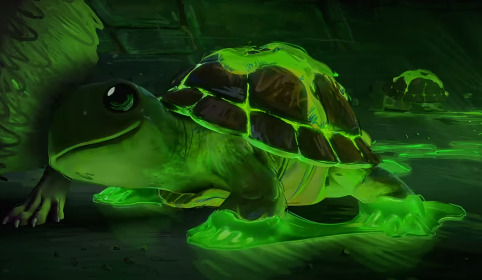
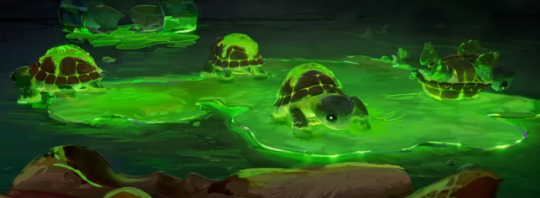
They look like box turtles. Because of the head and shell shape. My immediate thought was they'd be a three-toed box turtle since they're plain colored with no spots or patterns anywhere, BUT


They obviously have more than three toes. And the plastron looks nothing like any kind of box turtle's.
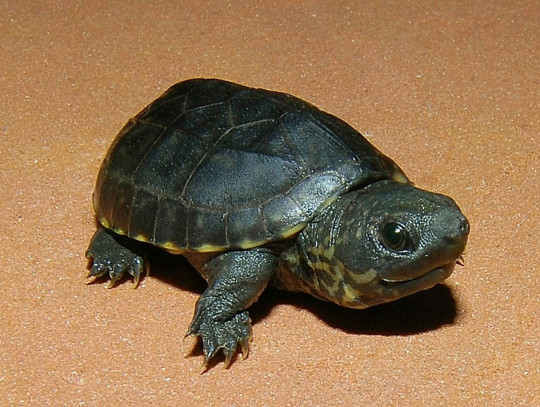
New lead: MUSK TURTLES!!!
2K notes
·
View notes
Text
The stinkpot, Sternotherus odoratus, is one of the three most widely distributed turtle species of North America. For it is found in a swathe of that continent, from as far north as the southern parts of Ontario and Quebec, southwards to Florida and Texas, although not at high elevations. This distribution has also named them the common or eastern musk turtle. Both the names 'stinkpot' and 'musk turtle' refer to a pungently smelling secretion that this species and its kin may produce when stressed.
Stinkpots are averse to fast flowing rivers and streams, instead frequenting swamps and marshes, pools, ditches, rivers with slower currents, and lakes. This is strictly a freshwater turtle species, and it does not tolerate brackish environments. These turtles are burrowers, and thus they require a soft substrate, never occurring on hard bottoms, and they are also averse to dense reedbeds. Although they are strongly aquatic, stinkpots emerge to bask on wood, and are actually able to ascend sloping, partially submerged trunks or branches for this purpose.
Basking behavior in S. odoratus usually takes place in shallow water, rather than completely emersed Naturally they also lay their eggs out of the water, as do all the turtles. Big S. odoratus have a carapace length up to 14 centimeters, or under 6 inches, but sizes closer to 10 centimeters, or 4 inches, are much more commonly encountered. Female S. odoratus are slightly larger than the males.
The stinkpot is just one species within the genus Sternotherus, which is in turn but one genus, among the wider kinosternid or musk turtle clade. Musk turtles are a quintessential North American clade of turtles, although they have a fossil record in South America since the Pleistocene. Therefore musk turtles are among the land animals that took part in the Great American Biotic Interchange, involving the migrations and extinctions of North and South American faunas, around the time the land bridge of Panama formed between the two continents.
Musk turtles belong to a turtle clade called the kinosternoids, that make their first appearance in the Late Cretaceous of North America, as aquatic, bottom walking turtles in low energy freshwater environments, as opposed to frequenting higher energy river channels. Ever since the Cretaceous period, the ancestral musk turtles were benthic, ambulatory omnivores with a preference for consuming animal materials. Although by the Eocene, a side branch of kinosternoids, named the dermatemydids, shifted into a herbivore niche.
Sternotherus however belongs to their kinosternid sister group, which includes all of the other extant kinosternoids. Kinosternids possess an efficient anti-predator defence, which is to discharge foul repelling, repellant acids, contained within their namesake secretion, when they feel stressed. Sternotherus and its close relatives have a particularly reduced plastron, or belly armor, and they possesses a novel hinge at its front end.
Similar plastral hinges have independently evolved in unrelated turtle lineages. Although it is widely assumed that such plastral hinges evolve to help 'box in' the soft, exposed tissue of the turtles that possess such hinges, in Sternotherus the hinge serves the opposite function, favoring the mobility of their proportionally large head, and co-evolving with another defensive behavior, of gaping whilst their head is retracted. Only in the related genus Kinosternon, but not in Sternotherus, does the plastral kinesis serve as a partial seal.
Like the ancestral kinosternoids from the Cretaceous and Early Palaeogene strata, modern kinosternids such as Sternotherus have remained benthic walkers, rather than active swimmers. Unlike some other freshwater turtles, such as the sliders and cooters, Sternotherus are poorly buoyant. Not all aquatic tetrapods are swimmers, and the swimming of benthivorous foragers does not need be rapid for them to find food at the pond bottom.
In field studies S. odoratus were found to prefer an environmental temperature of 24 degrees centigrade, although over its wide range, different populations will surely have locally evolved to meet local climate conditions. They cease to feed when the temperature is below 13 degrees, or above 35 degrees. Exposing these turtles to any higher temperatures must definitely be avoided.
Studies of this turtle in the aquarium confirmed that they are most active, when the temperature is 21 to 26 degrees, with a broader temperature tolerance of 18 to 30 degrees. When the water temperature drops as low as 6 to 12 degrees, these turtles become dormant. Although this species is dormant through the winter, in most of its range, it remains active all year in Florida. Interestingly the body temperatures of basking stinkpots was found to be no warmer than the ambient water, suggesting reasons other than thermoregulation usually explain their basking behavior.
In the colder, northern extremity of their range, S. odoratus actually are reliant on optimal basking locations, suggesting the faculative presence of heliothermy in this species. Where the water temperature happens to be lower or higher than the surrounding air temperature, emersion will obviously warm or cool the turtle. An option of thermoregulation that is off limits to most fish for example.
Given the wide geographical range of S. odoratus, and of the habitats in which it is present, parameters of water chemistry, such as pH, are unsurprisingly variable where it lives. A pH that is reasonably circumneutral ought to suit this species well. In the wild S. odoratus are often sympatric with painted and common snapping turtles, and these three species of turtle can be considered as comprising a faunal assemblage together.
S. odoratus vary in their diel activity patterns, but they are primarily crepescular turtles, most usually active inbetween the daylight hours, and the night time. Both diurnal and truly nocturnal activities have also been observed. Foragers rather than hunters, S. odoratus walk along the bottom with their necks outstretched, probing their faces into sand, mud, and decaying vegetation, to locate their food by its scent.
Stinkpots are generalists among freshwater turtle species, their omnivotous dietary spectrum including the consumption of animal carrion, and vegetable matter including seeds. Stinkpots are also benthivores, equipped with mightily powerful jaw musculature, and they are able to crack armoured prey.
Animals that they consume as they forage, include gastropods and bivalves, insects, and crayfishes. Almost all vertebrate material that stinkpots consume, is already or nearly deceased when the turtle recognizes it as food. They consume freshly dead items of carrion, but not those that are in advanced stages of decay.
S. odoratus will consume algae wafers, but 4/5 of their diet should be from appropriate animal food sources. This can be provided in sinking or defrosted form, or sometimes as fresh items from the fishmongers. Unlike many turtles they will normally refuse to eat green vegetables such as lettuce.
A common problem for pet turtle fanciers, is that most of the commonly traded turtle species grow too big after they are purchased at small sizes. Most species of musk turtle remain appealingly small when they are at mature growth, but as with other slowly ambulatory freshwater turtles, they will still require a tank footprint that is five times by three and a half times their carapace length. It's depth should be more than the length of their carapace, lest they fall on their backs and need to right themselves.
S. odoratus like to climb up to the water surface, rather than swim upwards, although they can actually swim competently enough. And although gaseous exchange occurs underwater, involving their skin surface and specializations of their tongue and throat surfaces, they must also be able to access atmospheric air. Allowing them access to the surface by clambering on sloping wood, is therefore mandatory. They do not need a true aquaterrarium with a land portion, but they should be able to surface and emerse.
Partially emersed and climbable wood decor, and a soft substrate at the bottom, constitute an ecologically appropriate aquascape for housing S. odoratus. Some live plants are likely to be eaten or dug up, though they aren't the most destructive of turtle species in a planted tank, and their consumption of green vascular plant material is relatively limited. Over the emersed basking spot, a basking lamp can be provided, but is not neccessary. Like humans, stinkpots benefit from UVB wavelengths, but they also uptake vitamin D from their food.
Adult stinkpots cohabit well enough with certain other species of turtle, as the painted turtles, cooters and sliders, and also North American softshells. They can however be aggressive towards each other, and to related turtle species, especially when the turtles involved are males. Large, healthy, powerful fish are also suitable cohabitants alongside these turtles, but small fish might well be taken whilst sleeping or otherwise sluggish. Although musk turtles are not efficient pursuit predators, the danger to small fishes is there, and such cohabitation cannot be condoned.
#Sternotherus odoratus#stinkpot#common musk turtle#eastern musk turtle#musk turtles#freshwater turtles#aquaterrarium pets
0 notes
Text
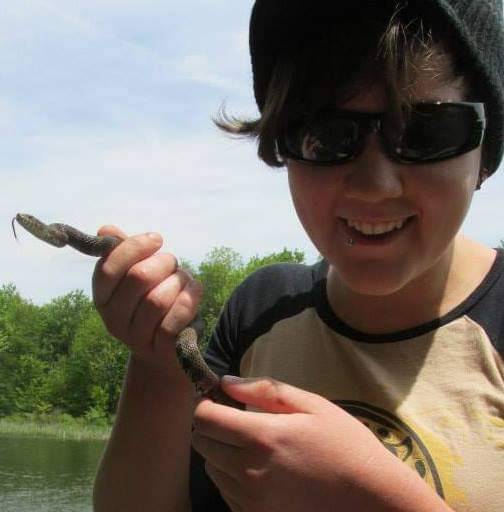
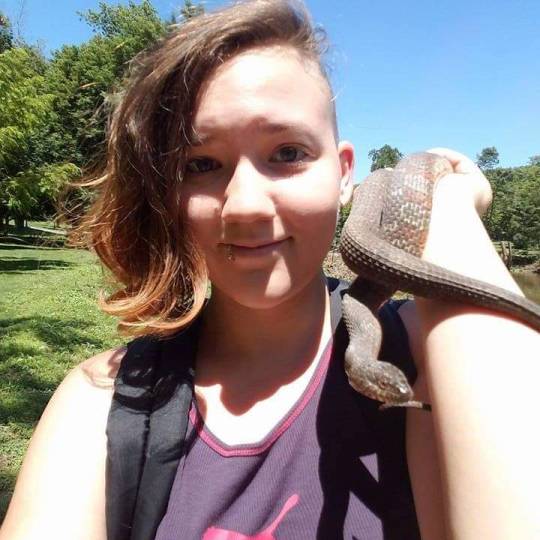

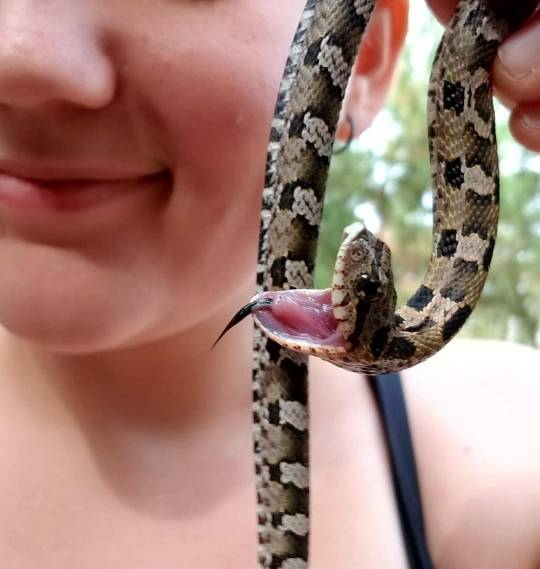
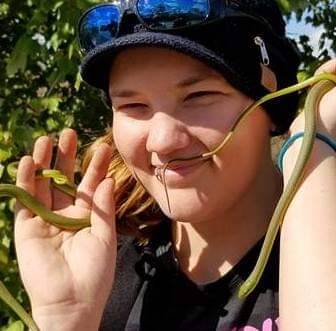
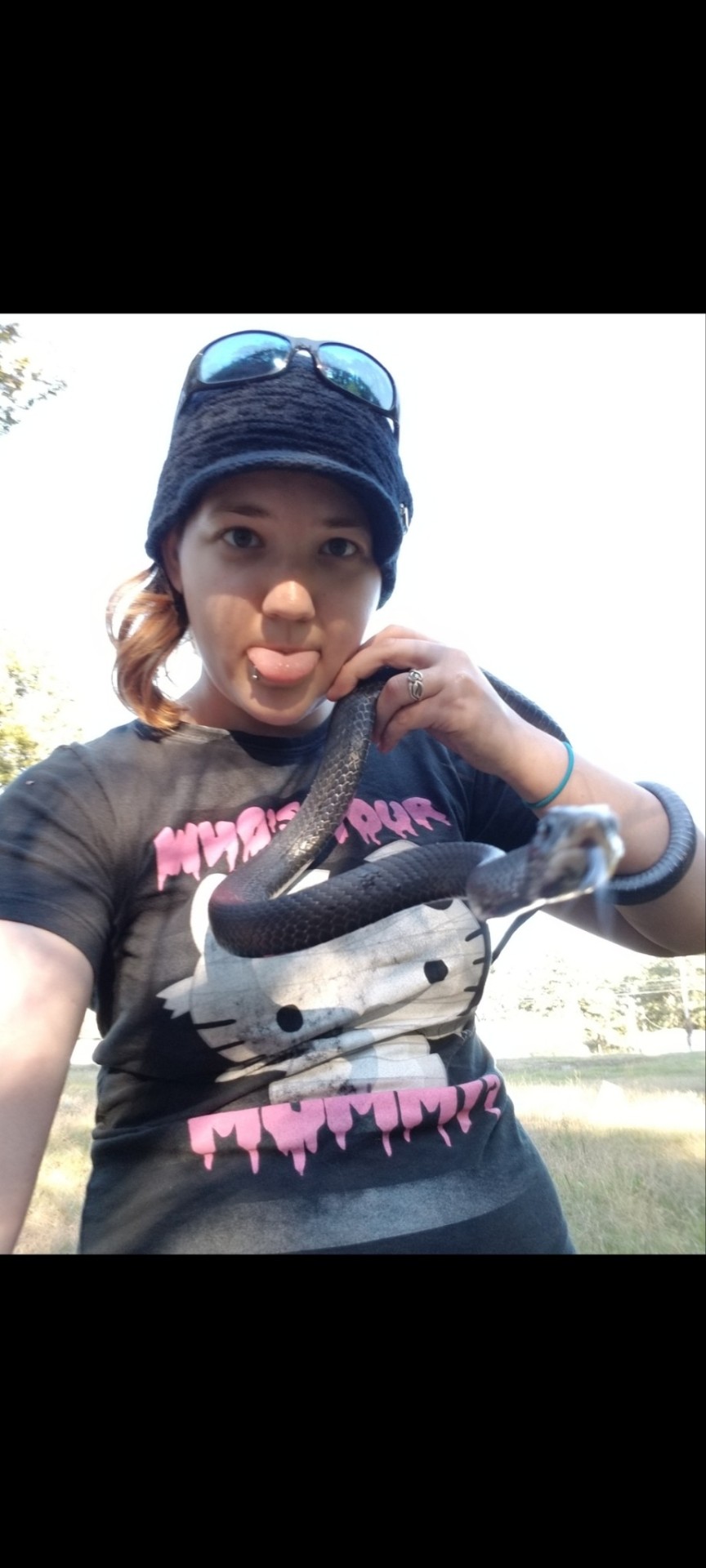
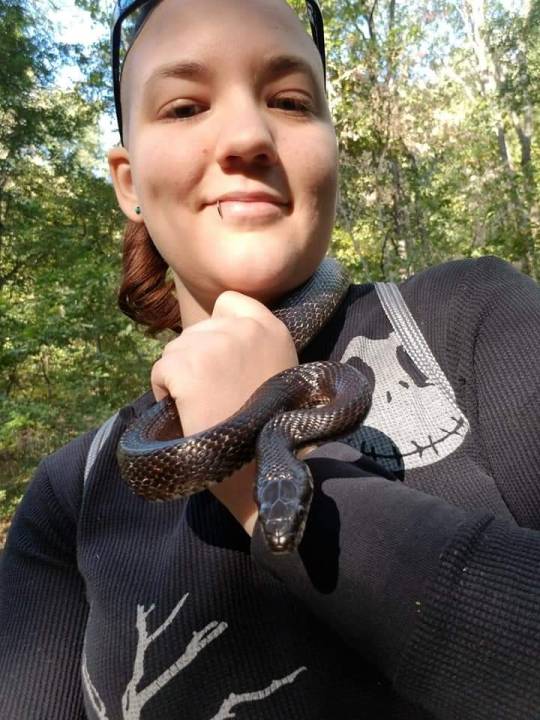
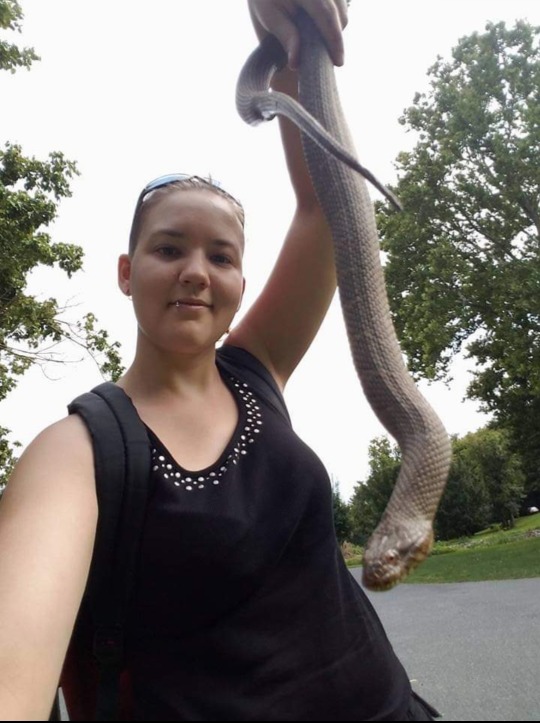

When in doubt... I like animals and the woods more than I like people.
#Enjoy these lovely photos of my face in different states of excitement while I'm covered in sweat dirt and snake musk. lol#1 & 2 = Northern Water Snakes#3= Eastern Black Rat Snake#4 = Eastern Hognose Snake#5 = Rough Green Snake x2#6 = Eastern Black Racer#7 = Black Rat Snake#8 = Northern Water Snake#Bonus - 9 = Common Snapping Turtle
6 notes
·
View notes
Text
i literally love doing 5 minute tmnt drawings that only make sense 2 me






#first 2 are the next mutation (they almost gave leo a lime green mask and donnie a black one)#th comic is bc i personally think venus should be an eastern musk turtle#tmnt#sprouts draws
6 notes
·
View notes
Note
if i can ask, your extensive post about lizards of maine made me really curious about what kinds of reptiles are in new england. garter snakes? turtles? are there any new england lizards?
New England Reptiles:
Hello, you wouldn't think that New England has that many reptiles, and in fact, there is only one species of lizard that barrrrrely ranges into far western Vermont. There are a decent number of snakes and turtles that range into New England.
Here's a list...
(According to the good book, the Peterson Field Guide to Reptiles and Amphibians of Eastern and Central North America)
Common Five-lined Skink
Eastern (Common) Snapping Turtle
Painted Turtle (Eastern and Midland subspecies)
Blanding's Turtle
Wood Turtle
Bog Turtle
Northern Diamondback Terrapin
Eastern Box Turtle
Eastern (Common) Musk Turtle - "Stinkpot"
Northern Black Racer
Eastern Milksnake
Smooth Green Snake
Eastern Worm Snake
Northern Ringneck Snake
Eastern Hognose Snake
Northern Watersnake
Dekay's Brown Snake
Northern Red-bellied Snake
Eastern Ribbon Snake (Common and Northern subspecies)
Common Garter Snake (Eastern and Maritime subspecies)
Eastern Copperhead
Timber Rattlesnake

Northern Five-lined Skink (Plestiodon fasciatus), juvenile, family Scincidae
photograph by Peter Paplanus

Common Snapping Turtle (Chelydra serpentina), family Chelydridae
Photograph by Sam Stukel

Timber Rattlesnake (Crotalus horridus), family Viperidae
Venomous.
photograph by Christina Shaffer
110 notes
·
View notes
Note
white-lipped mud turtle
Barbour’s Map Turtle
Black-knobbed turtle
yellow-blotched turtle
striped mud turtle
common musk turtle
eastern painted turtle
smooth softshell turtle
Indian Peacock softshell turtle
Matamata turtle (this one has a spiky body)
diamondback terrapin
bog turtle
ornate wood turtle
Turtles with cool shells and stuff, if you want it
Guess this is a place for questions so I’ll ask for your favorite turtle if you have one
JESUS that's a whole list right there goddam, thanks lmao XD
I.... haven't really actively thought about which turtle is my favorite before, they're all kinda neat (except that matamata turtle, it was scary!! .....but still kinda cool looking i admit)
I really really really like how for example black-knobbed turtle, yellow-blotched turtle and other turtles similar to them look, with the spikey shells. Metal as fuck! Most sea turtles are really neat too!
41 notes
·
View notes
Text
My UNprofessional opinion on The Last Ronin: Lost Years' new turtle team's species
because no one else is doing it WHERE ARE THE EXPERTS???
Warning: I didn't read the comics, all I know about the little 1's comes from au's, fanon contents, the snippets of comic pages I collected across the internet, and analysis videos (I can't read The Last Ronin comics, my heart can't take it), so don't take me too seriously, these are just guesses. Also, I don't know much about turtles, I just read a book one afternoon to find out more about the Rise turtles' species and take a look around the other turtles out of curiosity. And I read somewhere that they might not be just one species but a special combination of turtles to make the perfect soldiers? But I don't know, I still wanna do this so here we go (forgive my bad english):
So for starters, the first time I saw Uno I was automatically like "oh they used a Diamondback Terrapin hell yeah" and I'm pretty confident about my first guess because look at this:

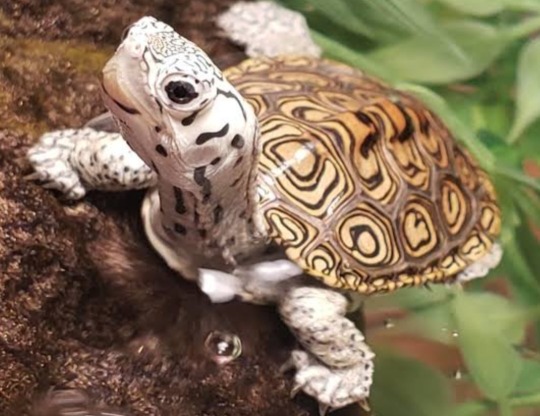
just look at it:
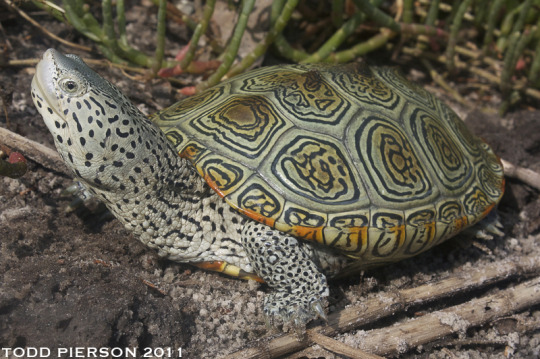
I don't think I need to explain myself here. Sure he doesn't have the diamond shape in his shell and his shellshape doesn't exactly match but I believe those are more of artistic choices rather than eliminating factors. Also I've never seen any other turtle species that has this color scheme (and again, I didn't see many) and I've seen so many Diamondback Terrapin designs for Venus and it's awesome, so
My first guess is Uno is a Diamondback Terrapin.
For my second guess, Moja, I have a lot of leads because her colors are more of brown tones rather than green and well, most turtles are green. So I looked up brown, light spotted turtles and I found a species called Eastern Box Turtle. Maybe not exactly spot on but I think its pretty close:
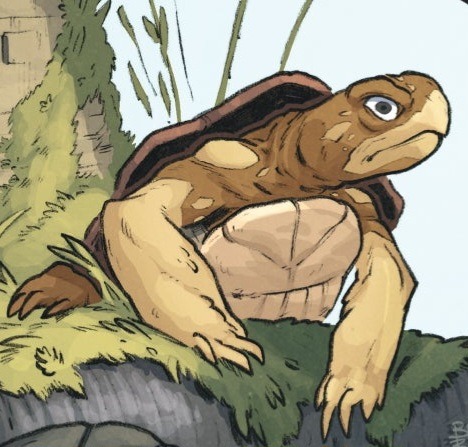
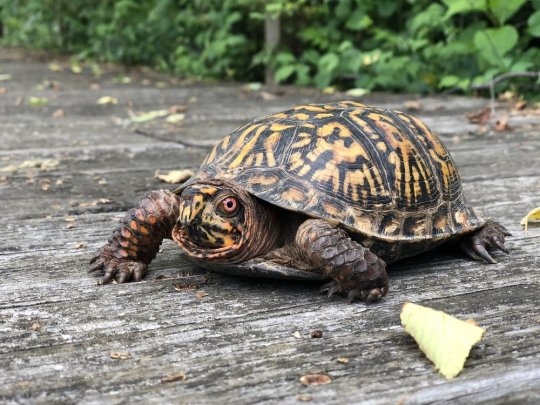
Ornate Box Turtles have various spots on their bodies so that would kinda match with her spotty skin and face markings.
But the shell is bugging me. Because Box Turtles have a very bumpy and round shaped carapace but Moja's shell is flatter and has an interesting shape that I think should be considered.
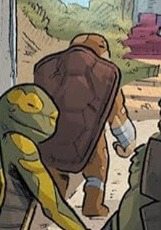
But I don't know so I'll leave it at that.
My second guess is Moja is an Ornate Box Turtle.
Now,
for Odyn,
I have no clue.
I don't wanna say Snapping Turtle because Rise Raph is already a Snapping Turtle and Odyn's shell is not spikey anyway. But I couldn't find any turtles that has spiky skin and smooth carapace so I went with vibes. And I found the Loggerhead Musk Turtle. Just look at how silly it looks:
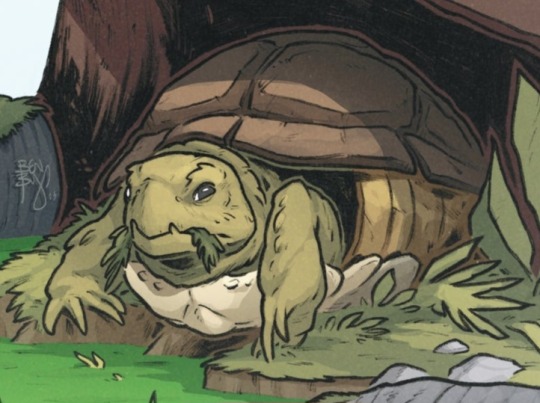
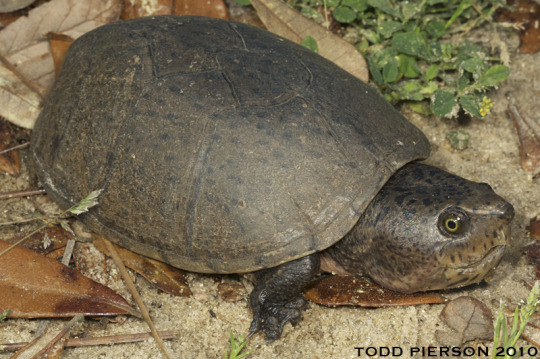
I think their sillines match and that's all I need.
My third guess is Odyn is a Loggerhead Musk Turtle.
Lastly, for lovely little Yi, I have a pretty good guess. Now if we look at her the most obvious clue that we have is her yellow markings across all of her body. They're not like Moja's spotty and round shaped markings tho, they're more stilty and linelike. Also her plastron is yellow enough to get my attention. And she's small. My guess doesn't really support that but at least they're smaller than my other guess, Florida Redbelly's. So, I propose: Yellowbelly Slider Turtle.
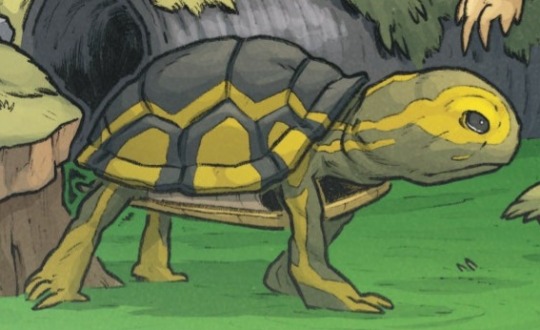
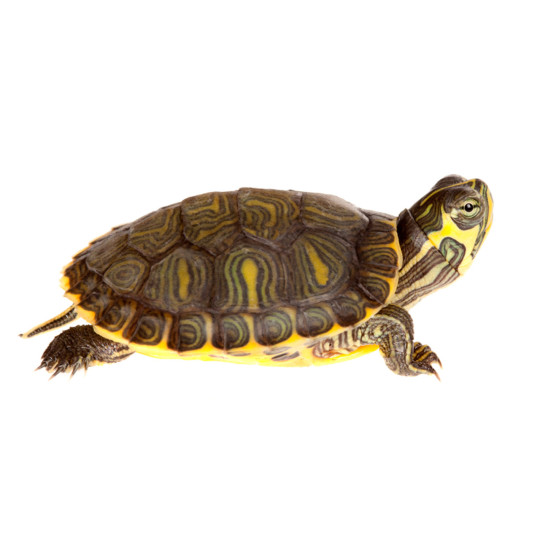
I'd say that's pretty close.
My fourth guess is Yi is a Yellowbelly Slider Turtle.
Maybe I should've considered their name's origins like Uno is Italian for one, Odyn is Ukranian or Russian for one, Moja is Swahili for one and Yi is Chinese for one, but I'm lazy.
Now please science side of Tumblr, turtle nerds, certain autistic fellas, TMNT fans, and all who's interested, correct me and my mistakes so that I can know their species I need to know I tell you I need to know.
#tmnt#rottmnt#the last ronin#tmnt the last ronin#tmnt lost years#tmnt uno#tmnt moja#tmnt odyn#tmnt yi#teenagemutantninjaturtles#tmntthelastroninuno#tmntthelastroninmoja#tmntthelastroninodyn#tmntthelastroninyi#tmnt 2012#tmnt 2003#turtle#turtles#turtlefacts#so this is how everyone puts the infamous tags#i'm just figuring out posting on tumblr and this is pretty fun#it's nice to hyperfixate into the void#i gotta do that more#but seriously#please answer my questions people#maybe i should tag science too#science#biology#marine biology
38 notes
·
View notes
Text


I'm at my folks' place in MO, and did some yardwork for them. The little eastern garter snake (Thamnophis sirtalis sirtalis) needed to be safely relocated to the woods in back of the house, and made sure to musk me thoroughly to voice their displeasure. The common box turtle (Terrapene carolina, maybe T.c. triunguis?) was taking a sunbath on top of the brush pile and was also gently moved nearby to avoid being buried in branch trimmings and weeds. It was nice to see these longtime friends while working.
#garter snake#snake#snek#herps#reptiles#herpetology#vertebrates#animals#wildlife#turtle#box turtle#turtles#terrapin#nature#ecology#environment#conservation#scicomm
19 notes
·
View notes
Photo
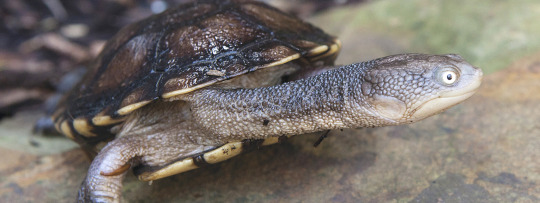
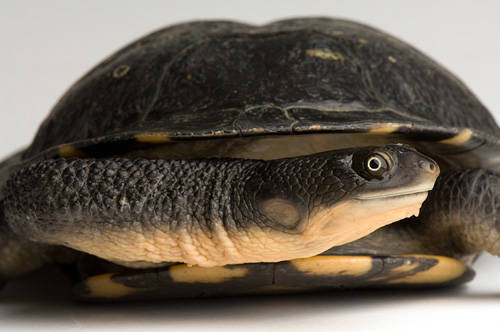
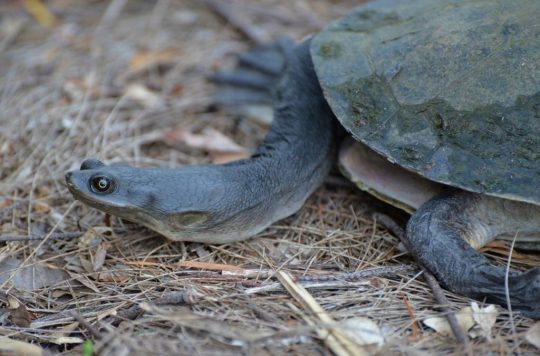
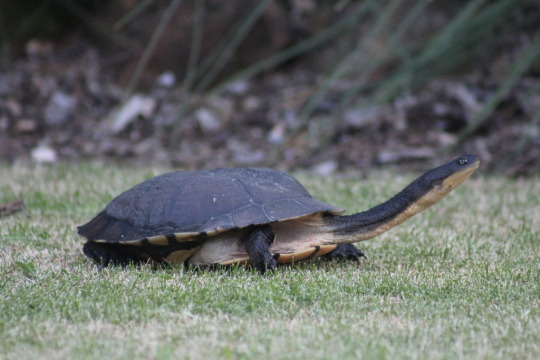
Get Along with the Eastern Long-necked Turtle
For my birthday, I’d like to focus on one of my favorite species: the eastern long-neck turtle (Chelodina longicollis). True to their name, they’re native to eastern Australia where they reside in a variety of habitats, including wetlands, streams, rivers, and dammed waters. In the winter when they become dormant-- a period known as estivation-- they can also be found under logs or leaf litter.
C. longicollis gets its common name from its unusually long neck, which is over half as long as its shell. Because of its length, the eastern long-neck turtle does not pull it directly back when threatened, but rather tucks its neck to the side for protection. The shell reaches about 28 cm (11 in) in length; the top is dark brown, but the underside has a distinctive orange and black pattern which varies from individual to individual. On average these turtles weigh 6 kg (13 lbs), although females are generally slightly larger and have a shorter, fatter tail.
The long neck of this species is useful primarily for finding food. The eastern long-neck turtle is carnivorous, feeding on aquatic invertebrates, fish, crustaceans, tadpoles, and carrion. Occasionally they also feed on terrestrial animals, mainly small amphibians and rodents. C. longicollis is an ambush predator, and its long neck allows it to strike quickly at prey. In turn, they are predated upon by a variety of animals, including larger lizards, snakes, birds of prey, foxes, and dingoes. The turtle’s shell provides an effective defense against these predators; in addition, individuals can emit a foul-smelling fluid from musk glands located near the base of the tail.
The eastern long-neck turtle is solitary. Individuals have large home ranges, and will frequently move when conditions become unsuitable. Territories can overlap, especially during the breeding season, which occurs from September to October. Males travel long distances to find females, and will often mate with more than one. Females lay their eggs from October to December in clutches of 8 to 24, in nests close to the water. The eggs take about 120 days to hatch, after which they are completely independent. Sexual maturity takes longer to reach than for other species; most individuals are only ready to mate at 7 to 12 years old, and can live up to 30 years in the wild. However, many hatchlings die long before then due to predation and high competition with other turtles.
Conservation Status: The IUCN has not evaluated the eastern long-neck turtle, although due to its large population and range it is considered Least Concern. Primary threats include habitat loss and predation by invasive red foxes (Vulpes vulpes)
If you like what I do, consider leaving a tip or buying me a kofi!
Photos
Rosie Nicolai
Joel Poyitt
Peter Storer
Joel Sartore
#eastern long-neck turtle#Testudines#Chelidae#snake-neck turtles#turtles#reptiles#wetlands#wetland reptiles#lakes#lake reptiles#rivers#river reptiles#freshwater fauna#freshwater reptiles#oceania#australia#east australia
348 notes
·
View notes
Text
Pictures I took yesterday of my family-friends’ turtle Waffles :]






She’s an Eastern Aquatic Musk Turtle (Sternotherus odoratus)!
22 notes
·
View notes
Text






So anyway im making my own tmnt ver. because i love these turtles--- mostly a thing for myself but if you wanted to see more i would happily how more!!!!!
Donnie(16) is an Eastern Musk Turtle Leo (15) is a Northern Map Turtle Ralph(15) is a Barbour's Map Turtle Mikey(14) is a Spotted Turtle
#tmnt#rottmnt#tmnt au#tmnt 2k12#teenage muntant ninja turtles#tmnt leonardo#tmnt donatello#tmnt raphael#tmnt michelangelo#vickingasart
112 notes
·
View notes
Text
@junoinouterspace showed off one of their cute little babies and made me wanna share my sillies as well




Got Atlas (Black-Knobbed map), Token (Eastern musk), Slick (Yellow bellied slider), and Digit (Chinese pond turtle- I call her Digeridoo)
(If you want me to remove the tag I will btw)
#They're all just so sassy#Each one of them has a different personality though still#Atlas (the first one) is definitely the sassiest of the four#turtles#pets
17 notes
·
View notes
Text
Reincarnated AU: the 2012 turtles reincarnated into the rise universe!
Premise: A witch from Witch Town (i cant believe its named witch town) wants to make his own version of the hero turtles. This takes place a full year after the Rise Kranng invasion and the Rise turtles are famous for being the 'Saviors of the World'. A witch wants to make his own turtle warriors. But he spends little effort into getting the turtles and he grabs;

One Common Musk Turtle,

One Eastern Mud Turtle,

And two Spotted Turtles.
And he uses magic, and says, "bring me the souls of four great ninja warriors" to put into his turtles.
And he then puts the souls of 2012 Leonardo, Raphael, Donatello, and Michelangelo into his turtles.
They died fighting an alien invasion in their dimension, and were going into the afterlife, but the spell brought their souls into new mutant turtles.

(ignore the fact i spelled their names wrong in the corner T^T)
They kept their original eye color from their dimension because you know, "eyes are the window into the soul" and all that.
Wanna read the fic?
Read it here:
Chapter 1
Want to see more?
Search the morph’s au tag on my tumblr!
#tmnt 2k12#tmnt fanart#rise season 3#rise of the tmnt#rise of the teenage mutant ninja turtles the movie#rise of the teenage mutant ninja turtles#tmnt 2012#tmnt au#tmnt 2k18#rise leonardo#rise donnie#rise raph#rise mikey#tmnt leo#tmnt michelangelo#tmnt donatello#tmnt raphael#teenage mutant ninja turtles 2012#teenage mutant ninja turtle imagine#fanart#tmnt fanfiction#fanfiction#morph’s au
92 notes
·
View notes
Text
What if I…?
Big Mama turns to retrieve an item from her desk then returns to lower it to Jennika’s front. In her hands is a white mask with red, sharp eye slits and thin line markings mimicking sharp teeth. Below the mask sits dark-colored attire folded neatly into a square.
Jennika looks at the mask then up at Big Mama, curiosity evident in her expression as she outstretches her hands.
Big Mama placed the mask in Jennika’s hands as she said, “This is for those dreadful stripes of yours, my turtley-boo.”
Jennika forced her shoulders to remain in their place, but hearing those words from her mother hurt. She thought her stripes were unique, she thought they were pretty, she thought Big Mama liked them too.
But if this was the price for Big Mama’s affection, then she will gladly hide her face away forever.
And what if…?
Venus trembles before the spider yokai, but her hardened gaze doesn’t falter—not even when the woman leans forward to cup a thumb and finger under the young turtle’s chin to look up. Her gaze doesn’t break as Big Mama forces her to look left and right, up and down.
Big Mama’s hand jerks Venus away, almost shoving the musk turtle away.
“How would you like to earn your dues?” Big Mama asks as she steps back and looks around the shack. Her expression shows she’s not at all amused by the decor—or lack thereof.
Venus watches Big Mama with a cautious eye, setting aside her comic to give the spider yokai her full attention.
“Jenny wants me to stay home,” Venus reminds Big Mama. Her fist tightens at her side, urging herself to remember Jennika’s words that are ingrained into her mind.
Big Mama spins on her heel, the smile on her face more skin-crawling than before.
“But is that what you want, Small One?”
For now this idea sits in my drafts as Estranged, but I still need to do my “research” on these two before anything is set and stone. It’s hard to find info on their characters that won’t lead to me diving deep into IDW and forgetting what I originally came for.
I have a synopsis written out for this idea but it’s still a work in progress.
Anyways, for now it’s Painted Turtle Jennika and Eastern Musk Turtle Venus.
#rottmnt#rise of the teenage mutant ninja turtles#tmnt jennika#tmnt venus#big mama rise#rottmnt fanfiction#rottmnt fanfic wip#rottmnt au#rottmnt lost sisters au#estranged au
26 notes
·
View notes
Text

Common Musk Turtle aka Stinkpot Turtle (Sternotherus odoratus), family Kinosternidae, found in the eastern and central United States
photograph by José Garrido
#stinkpot#turtle#musk turtle#sternotherus#kinosternidae#reptile#herpetology#animals#nature#north america
287 notes
·
View notes
Text
guess who has their own tmnt iteration!

i havent decided on the name yet and im still making some character sheets but i finished this drawing and ive been wanting to post about these guys for ages. im going to out some basic info about the guys under the cut :)
Leo: He/Him (for now)
Age - 18
Species - Barbour’s Map Turtle
Mikey: He/They
Age - 15
Species - Eastern Painted Turtle
Raph: They/Them
Age - 15
Species - Southern Painted Turtle
Donny: He/She/They
Age - 13
Species - Loggerhead Musk Turtle
#tmnt au#tmnt art#tmnt leonardo#tmnt raphael#tmnt donatello#tmnt michelangelo#tmnt iteration#n.s art#fanart
15 notes
·
View notes